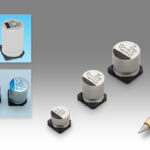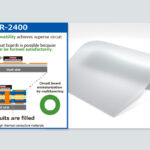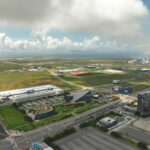ASIA ELECTRONICS INDUSTRYYOUR WINDOW TO SMART MANUFACTURING
Panasonic Industry Releases First AI-equipped Servo System
Panasonic Industry Co., Ltd. has commercialized the MINAS A7 Family servo system, the first in the industry equipped with artificial intelligence (AI)*1. As a result, it automatically performs precise tuning superior to that done by human experts. The revolutionary servo system also achieves the industry’s highest*2 degree of motion performance[1]. The product will be launched in January 2024 in Japan, followed by a global rollout.
*1: As of the commercialization of general-purpose servo system on September 13, 2023. Panasonic Industry data.
*2: As of Sept. 13, 2023, as a servo motor (output: 200 W) and servo amplifier (output: 200 W). Panasonic Industry data.
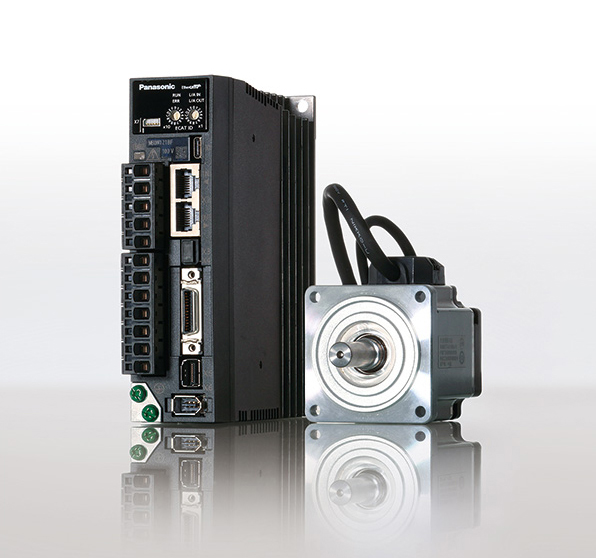
The technology for automating servo motor tuning has been evolving. However, conventional automatic tuning was unable to achieve satisfactory results for equipment that requires ultraprecise positioning performance. These include semiconductor manufacturing equipment and electronic component mounting machines. Specifically, these machines require sophisticated manual tuning skills achieved by engineers recognized as experts.
Meanwhile, the new product automates such precise tuning work, previously only attainable by human experts, by fully leveraging AI technology. It has become possible to reduce the positioning settling time[2], which is an indicator of positioning performance, by 45%*3 (compared to previous human results), and operation time required for tuning by 90% or more*4.
*3: Measurements under Panasonic’s experimental environment. Measured settling time until the positioning deviation converged to the predetermined positioning range.
*4: Measurements under Panasonic’s experimental environment. Measured tuning operation time until the positioning deviation converged to the predetermined positioning range.
In addition, the speed response frequency[3], which is the basic performance of servo system, is the industry’s highest*1 at 4.0kHz or more (1.25 times*5 that of Panasonic’s conventional product). Also, the encoder resolution[4] is the industry’s highest*1 at 27 bits (134,217,728 pulses/rotation). These results will contribute to the improvement of equipment performance.
*5: Compared to Panasonic’s conventional MINAS A6 series servo motor (output: 200W). Panasonic Industry data.
Panasonic Industry will contribute to the improvement of the performance of customer equipment. At the same time, it will promote energy saving through reduced waste due to the inferior quality of products manufactured by such equipment, and improved equipment cycle time[5].
Servo System MINAS A7 Family Features
1. The industry’s first*1 commercialized AI-equipped servo system, which achieves precise automatic tuning superior to that done by human experts, thereby reducing operation time by 90%.
Panasonic’s independently developed precAIse TUNING, which makes full use of AI technology, achieves precise automatic tuning. It even automates tasks in areas where experts used to spend time tuning manually due to unsatisfactory performance from conventional automatic tuning functions.
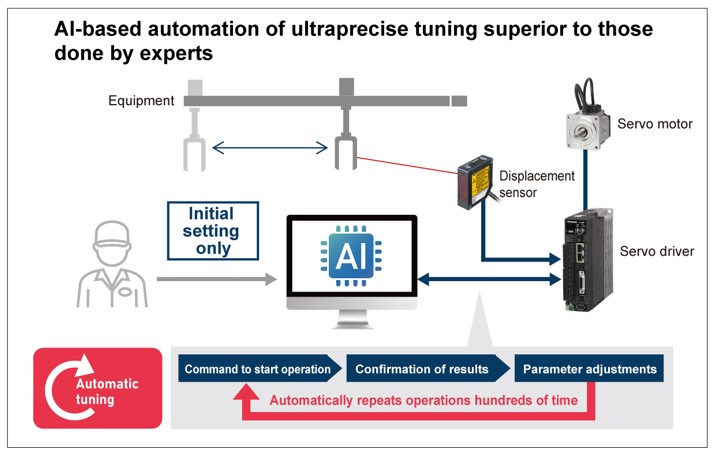
Equipment that requires ultraprecise positioning accuracy, such as semiconductor manufacturing equipment and electronic component mounting machines, requires tuning that precisely regulates the vast number of parameters for each individual piece of equipment’s characteristics. This necessitates the sophisticated knowledge, senses, and skills of expert engineers.
In addition, there are some cases where even such experts require several days to a week to achieve the required performance. Equipped with precAIse TUNING, this product automates precise tuning that was previously performed manually by experts to enable users to achieve positioning superior performance through simple initial settings.
The settling time for positioning, which is an indicator of positioning performance, is reduced by 45% compared to experts’ results, and operation time required for tuning are reduced by 90% or more.


2. Achieves the industry’s highest*2 level of motion performance
It achieves the encoder resolution of the servo motor with 27 bits (134,217,728 pulses/time), an industry high. The speed response frequency, which indicates the control performance of servo amplifiers, reaches an industry high of 4.0kHz or greater (1.25 times that of Panasonic’s conventional product). These results will contribute to the improvement of the positioning and processing accuracy of customers’ equipment. Furthermore, the servo motor has achieved a maximum rotation speed of 7,150 r/min. The improvement of the operating speed for equipment will contribute to shorter cycle times.
3. The application-specialized servo amplifier effortlessly achieves high-precision control
Normally, the control of servo motors requires complex control programs in controllers, such as PLCs. The sensor direct feedback (displacement control) type servo amplifier adopted for this product improves the system’s responsiveness from the input of the sensor to the output to the servo motor, wherein the amplifier itself directly captures sensor data without going through controllers. Eliminating the need for creating complex control programs for controllers enables high-speed and high-precision control. This will contribute to the reduction of man-hours for customer program development.
In the future, Panasonic Industry plans to sequentially expand the lineup of application-specialized servo amplifiers, such as high-precision gantry control type and sensor direct feedback (pressure control) type products.
Panasonic’s new servo system suits semiconductor manufacturing equipment, electronic components mounting machines, machine tools, industrial robots, and more.
Moreover, with an eye on strengthening global production systems, production will take place in the Tatsuno Factory in Hyogo Prefecture, Japan. This is in addition to the Zhuhai Factory in Guangdong, China, which is the current manufacturing base of our servo system.
Term Description:
[1] Motion performance
Performance related to responsiveness and positioning accuracy, which are indicators for servo system evaluation. Performance is generally evaluated based on speed response frequencies. Basic specifications such as encoder resolution are elements that result from speed response frequencies.
[2] Positioning settling time
The elapsed time from the completion of the positioning command until the target positioning range, which is determined by the required accuracy, is achieved.
[3] Speed response frequency
An indicator of how quickly a motor can respond to a given speed command. The larger the frequency value, the higher the control performance of the motor.
[4] Encoder resolution
The number of pulses output per motor rotation. The larger the value, the higher the accuracy of the encoder.
[5] Cycle time
Actual time required to manufacture one product. It is expressed as an equation of the regular operating time break time per day, divided by the actual daily production quantity.

